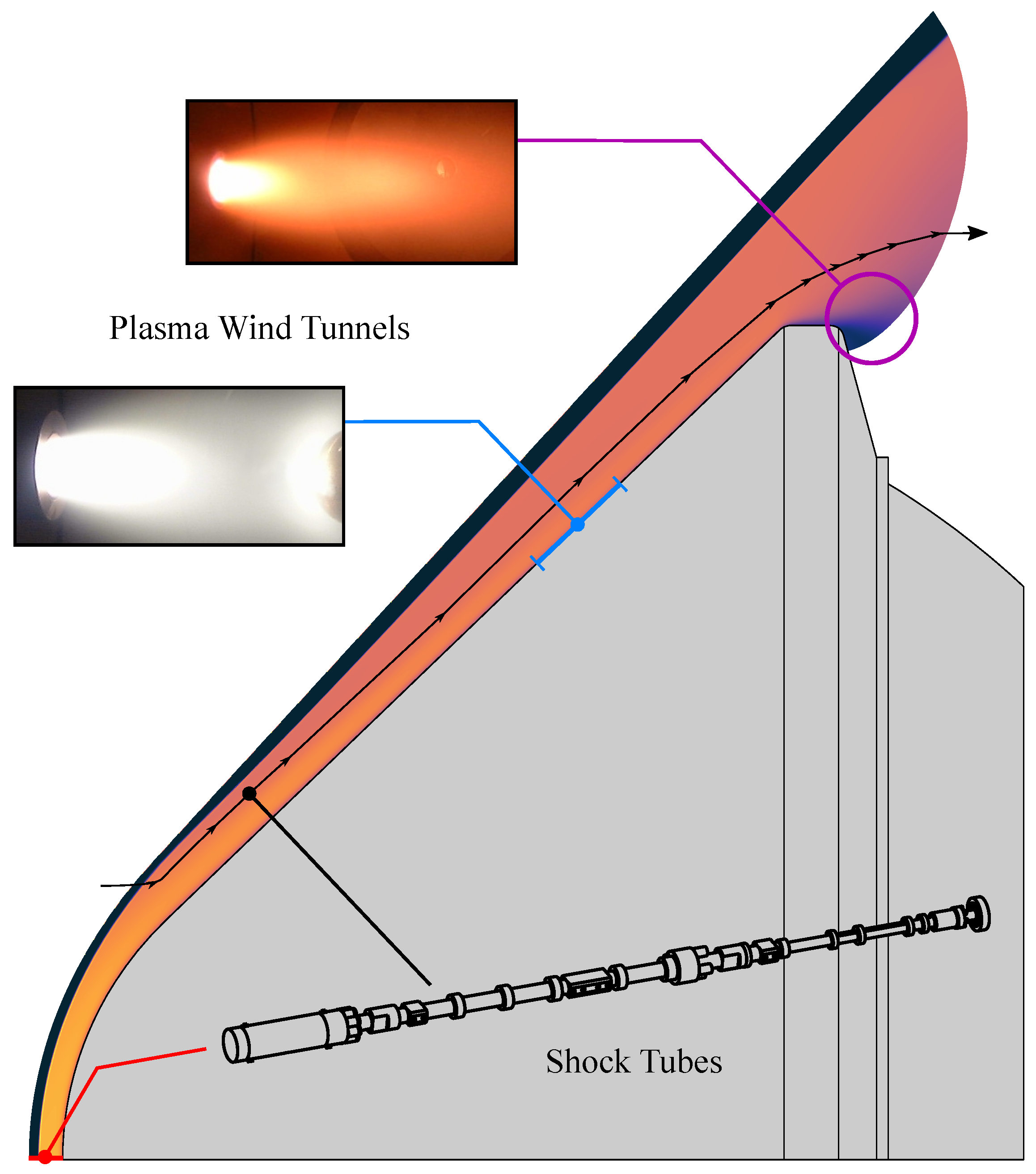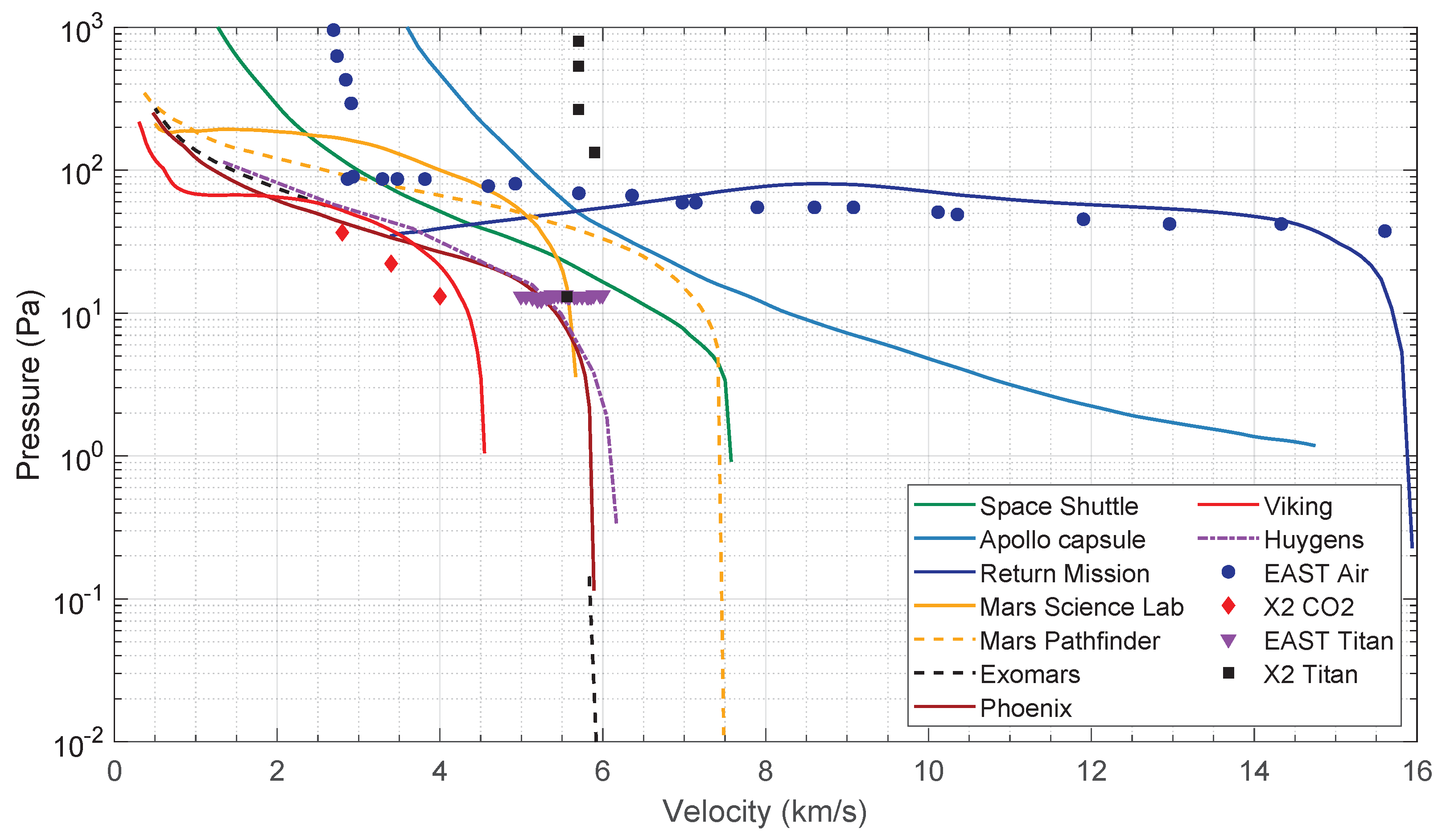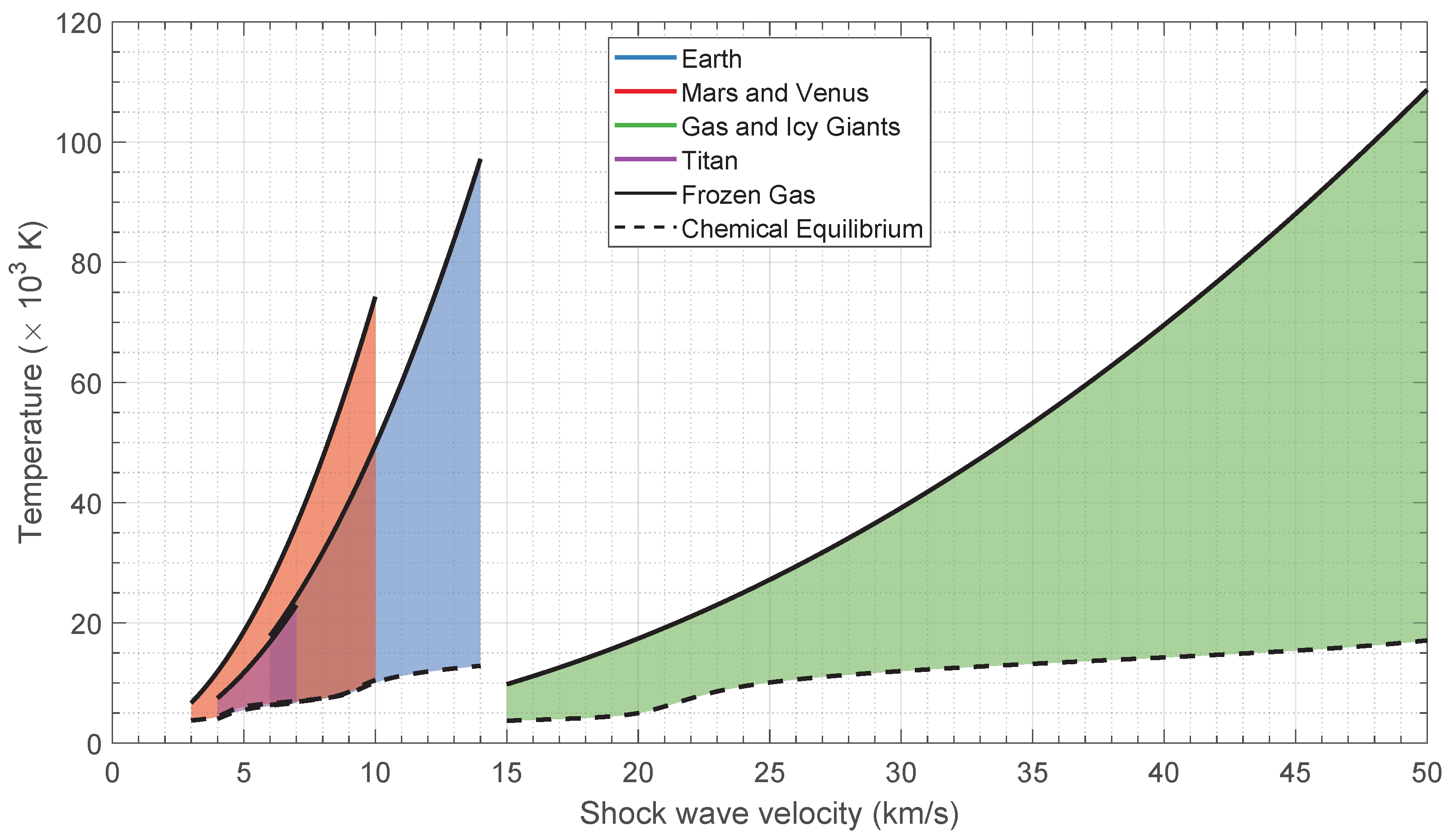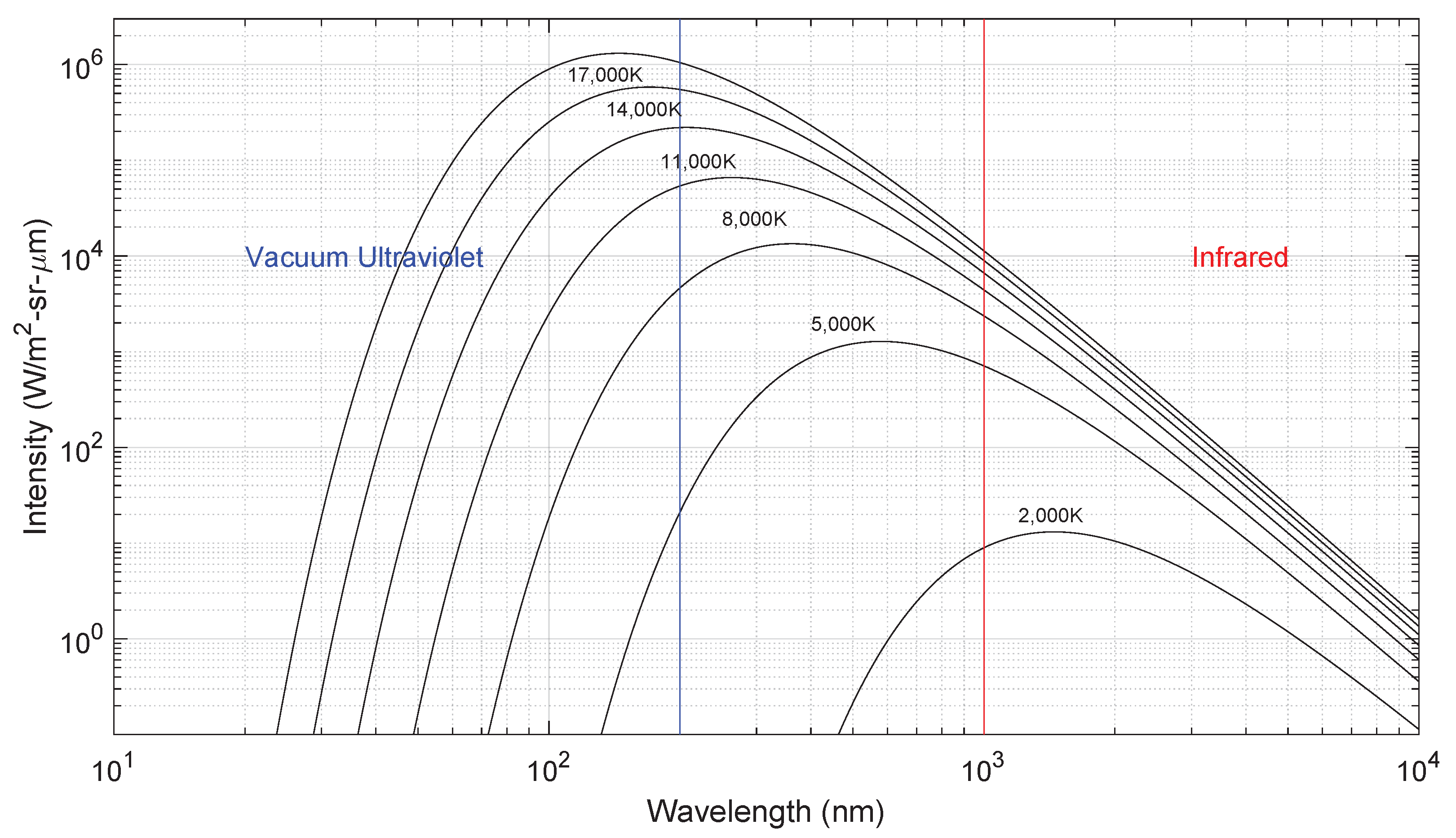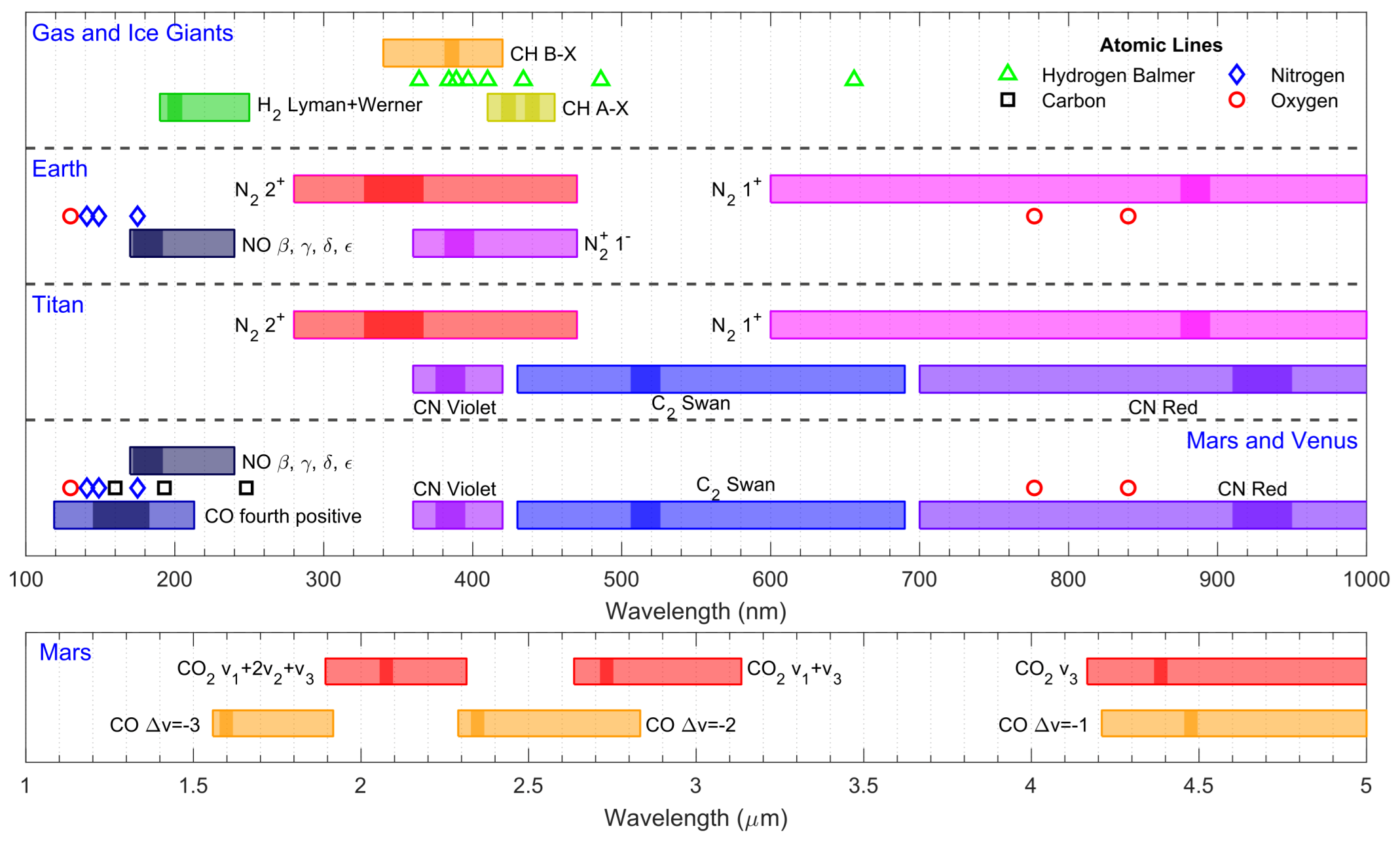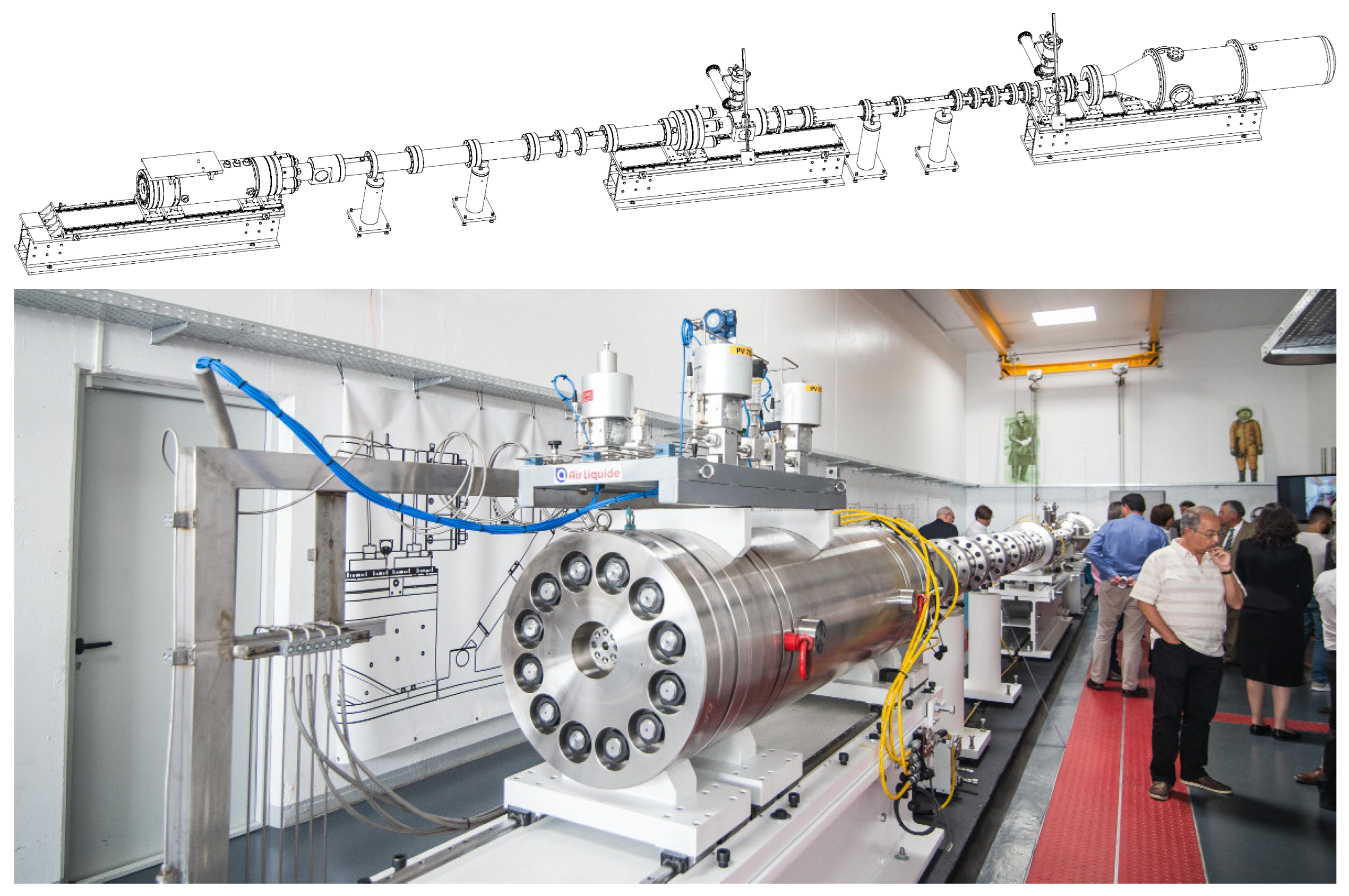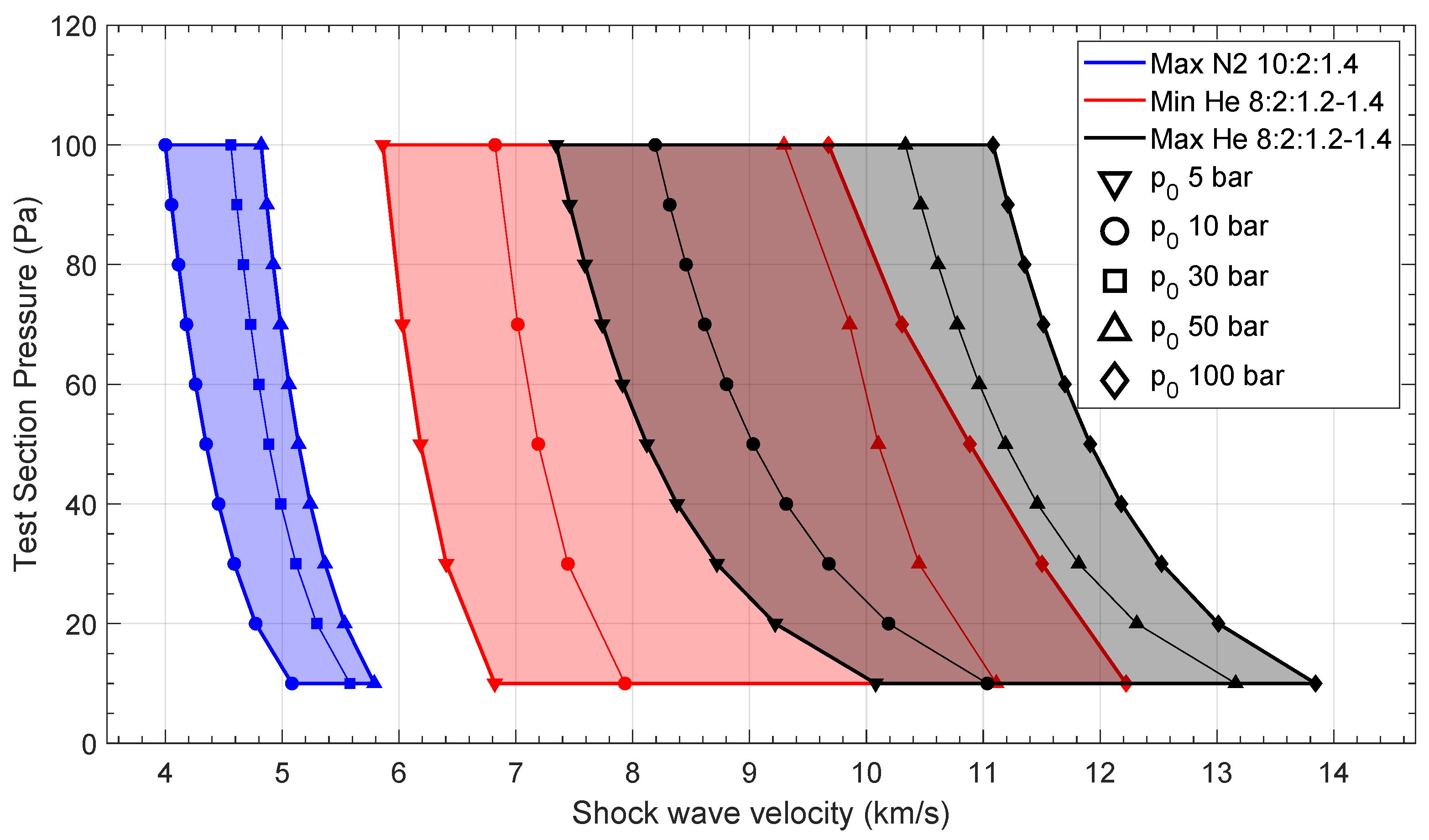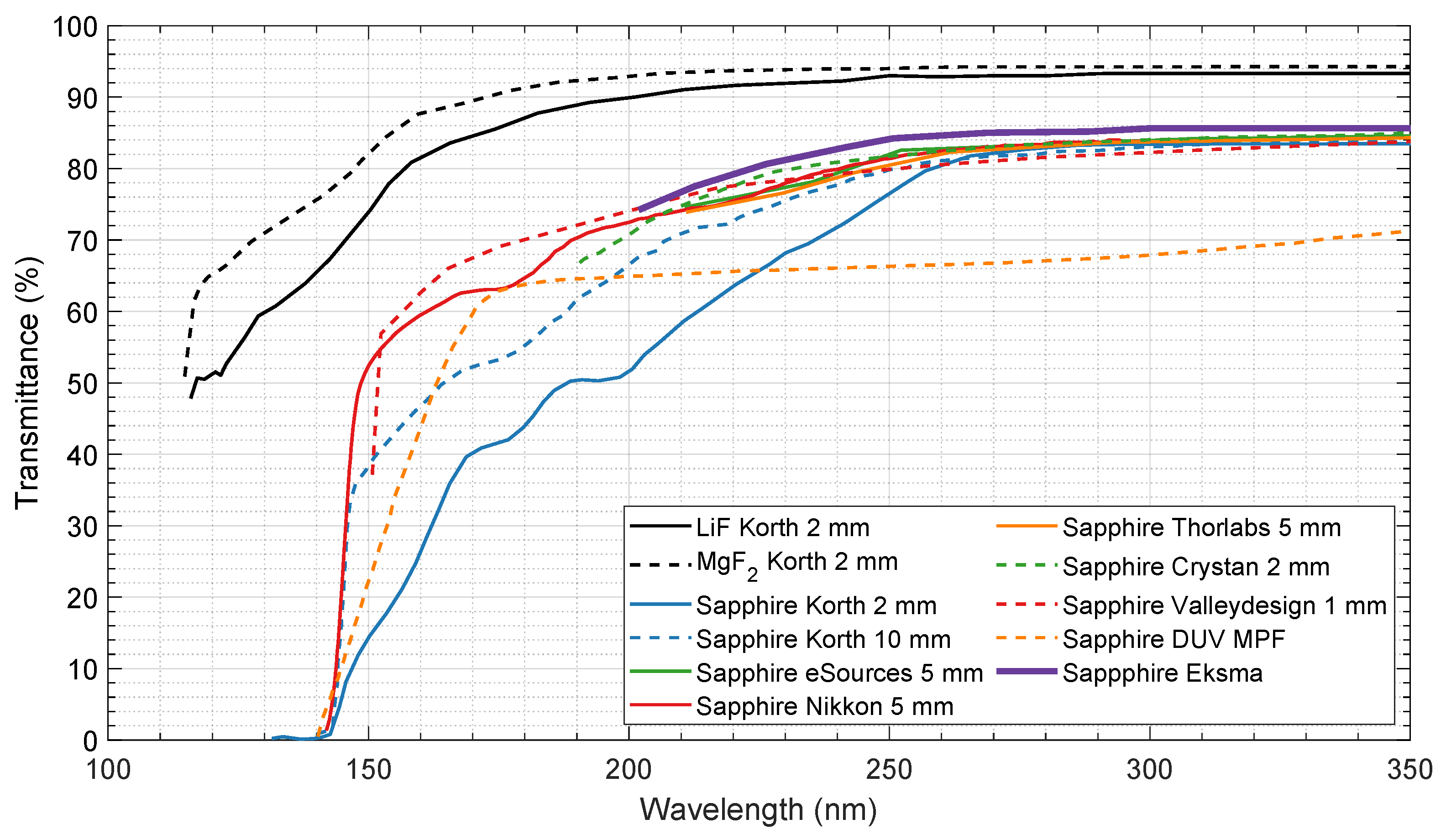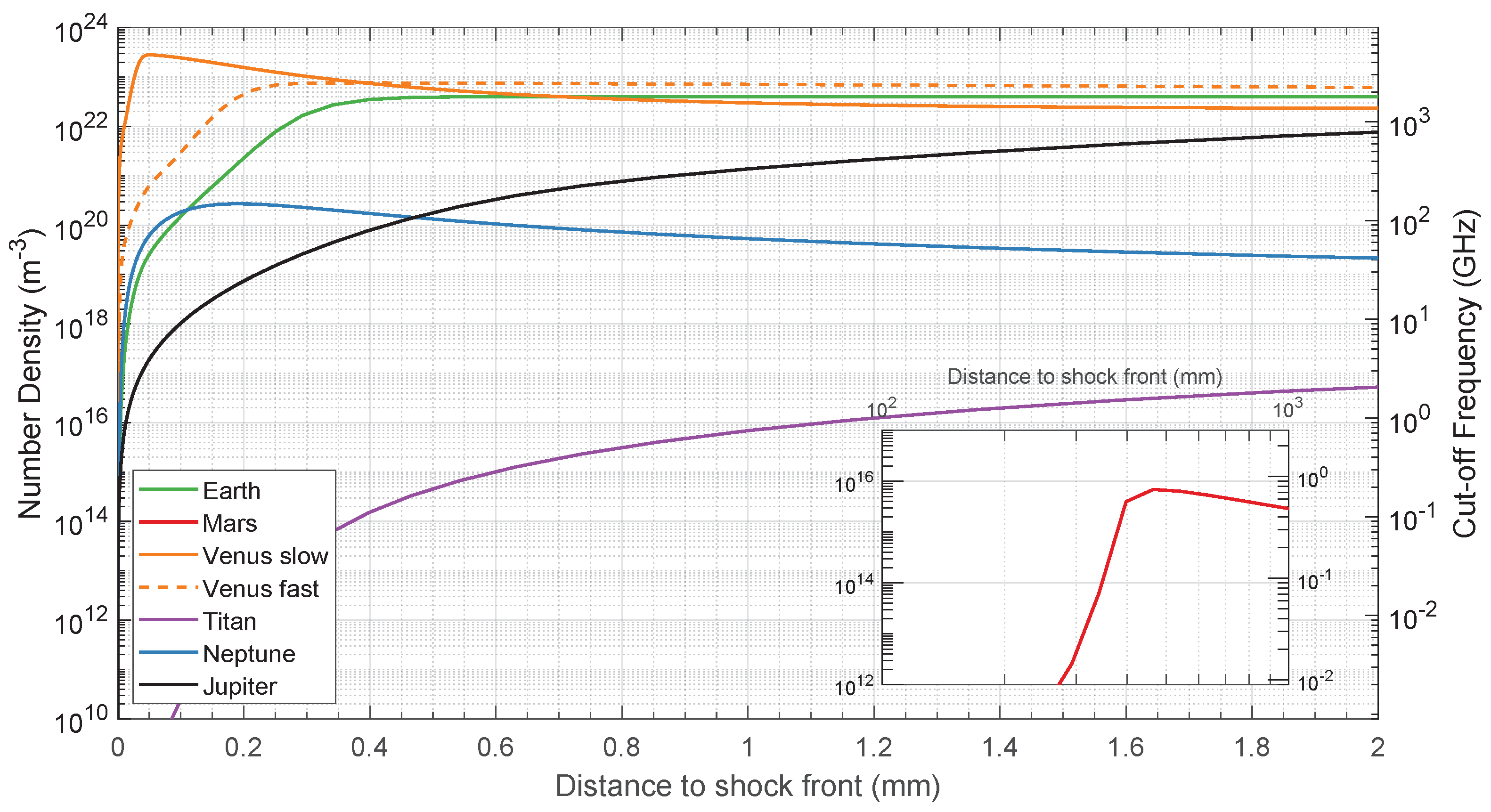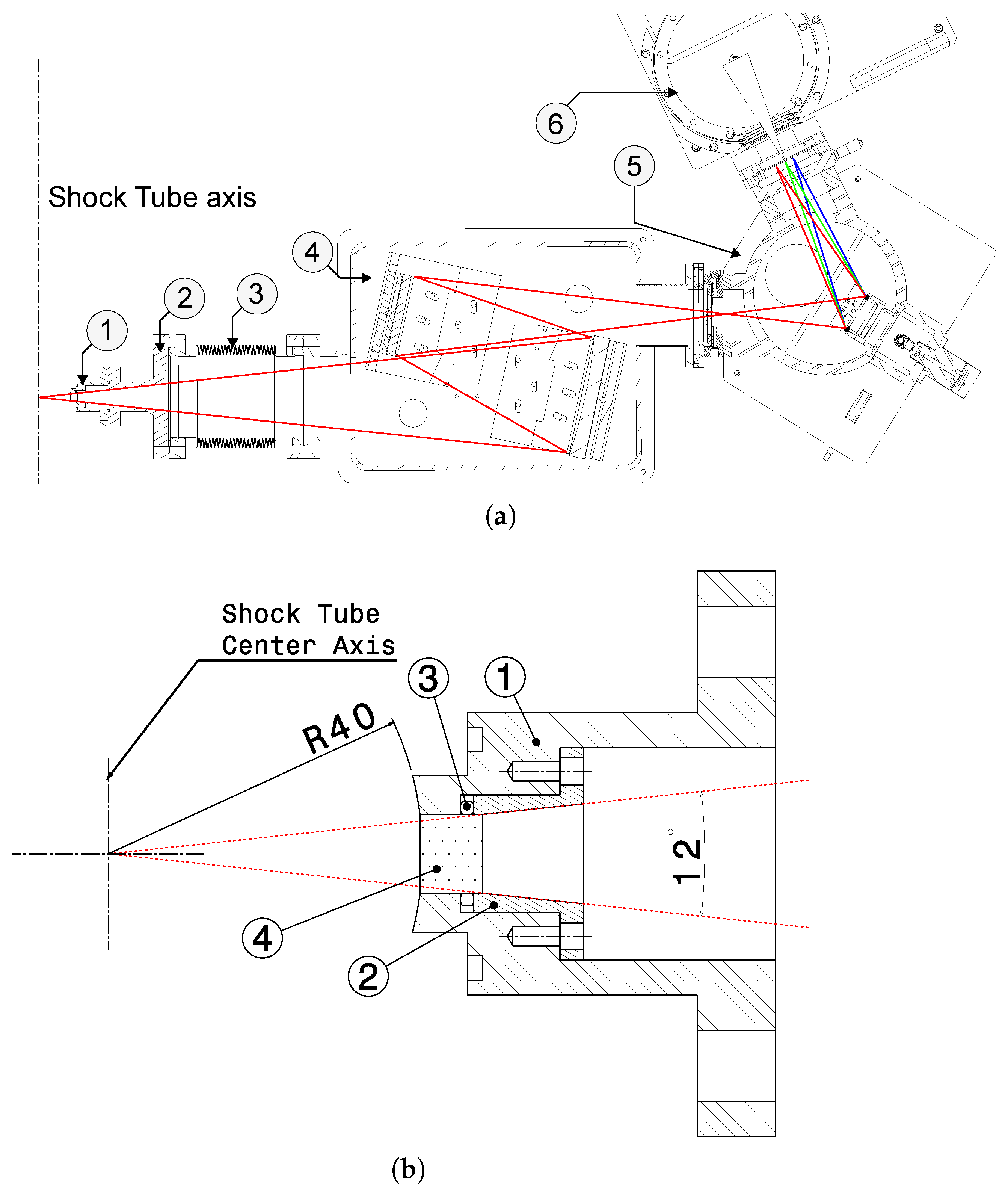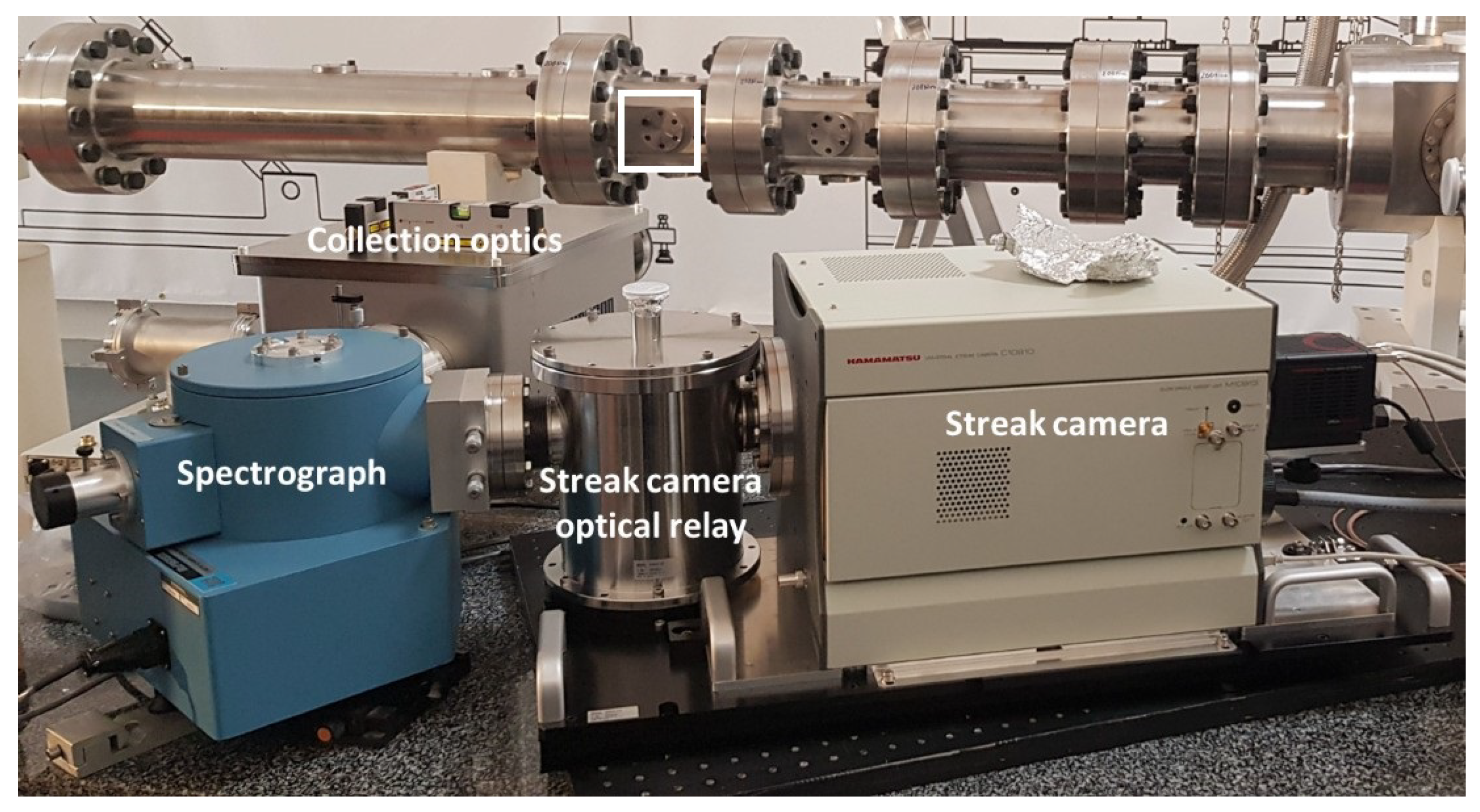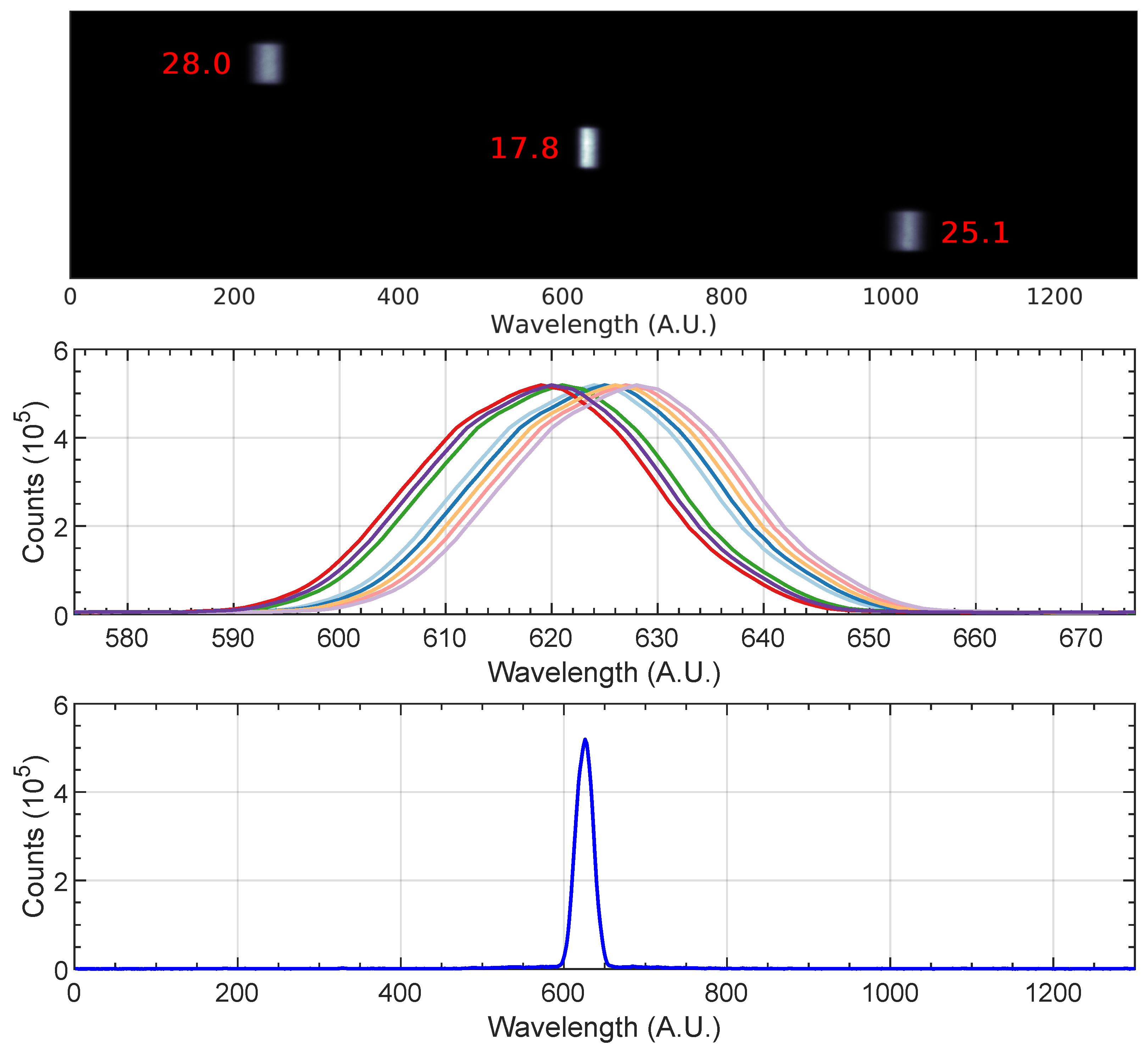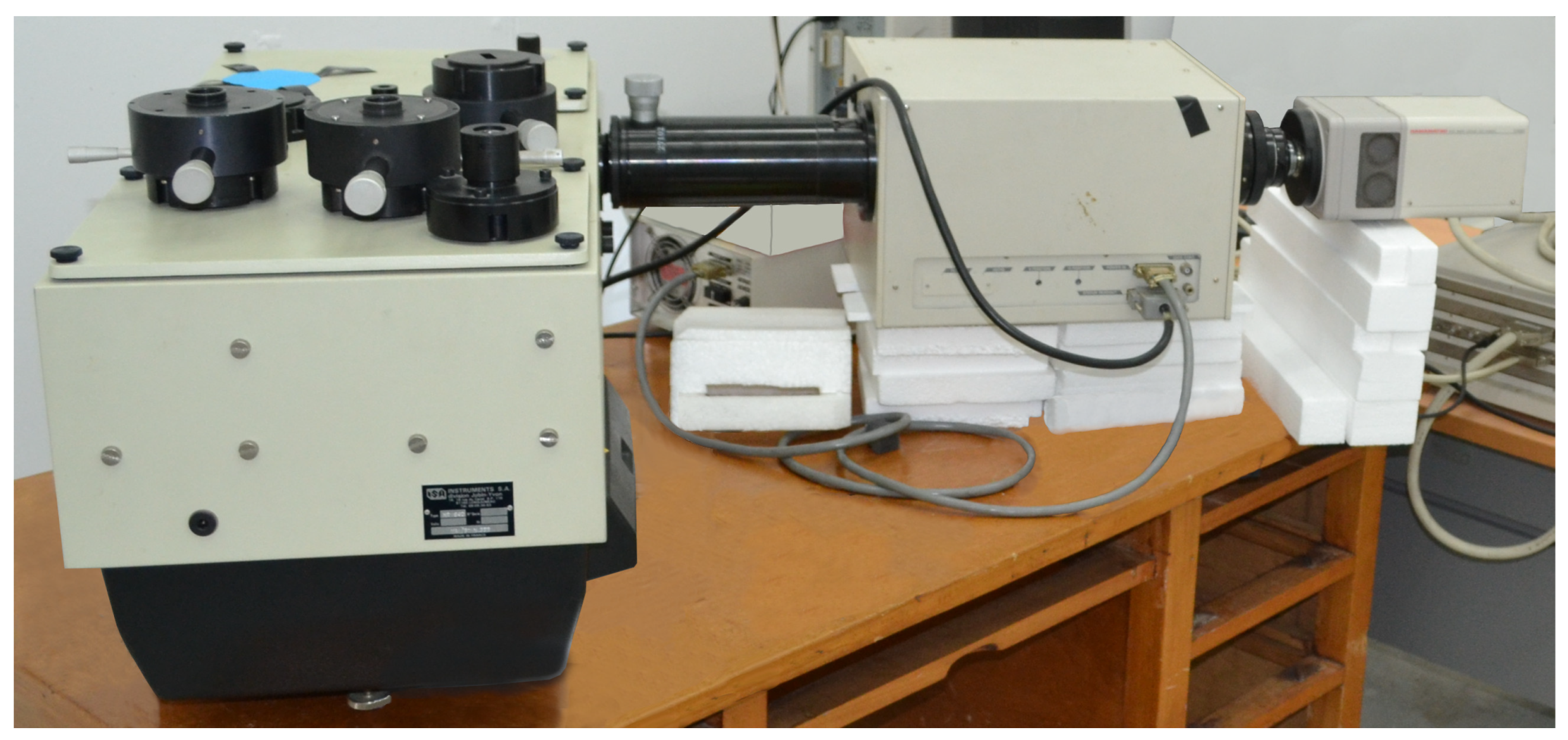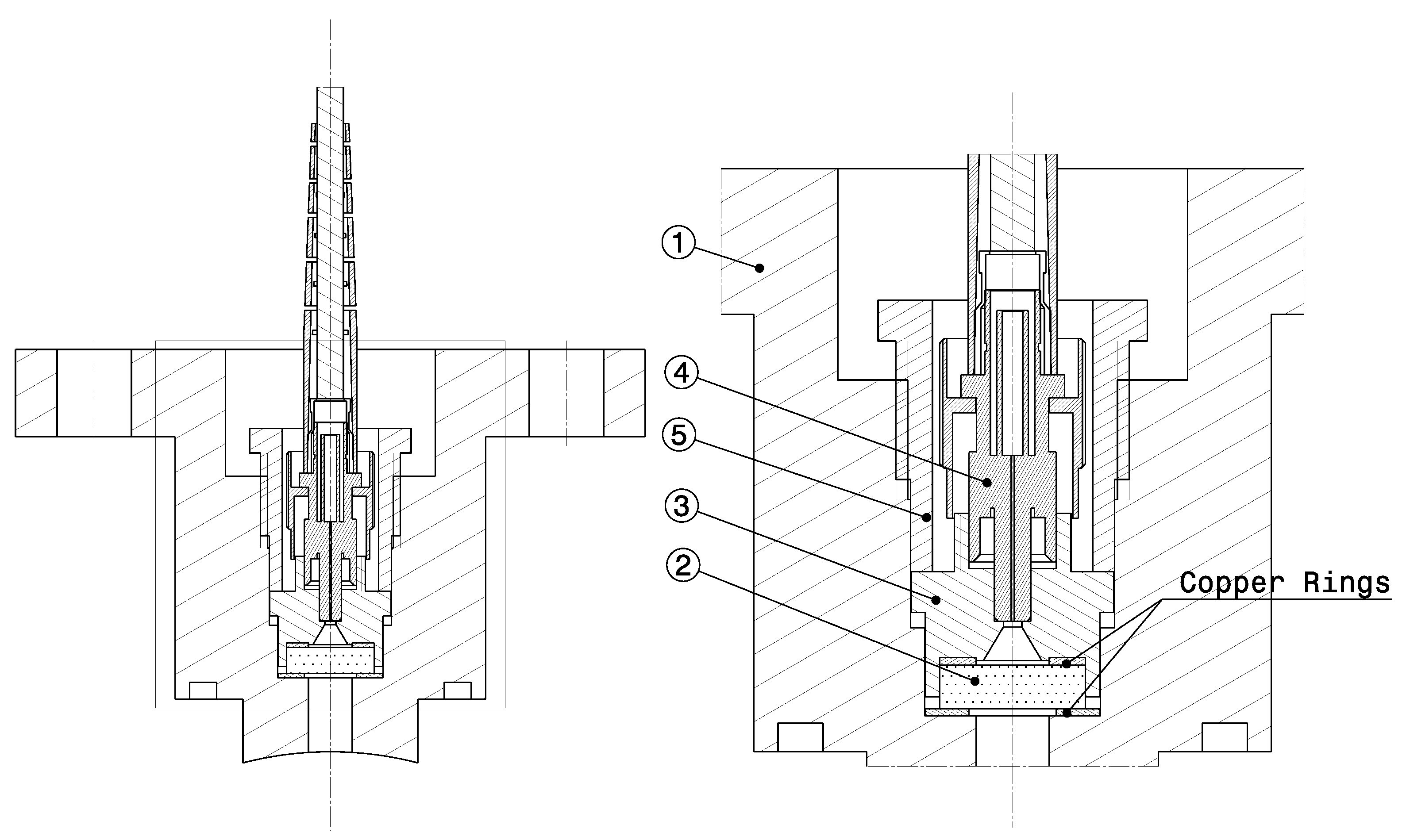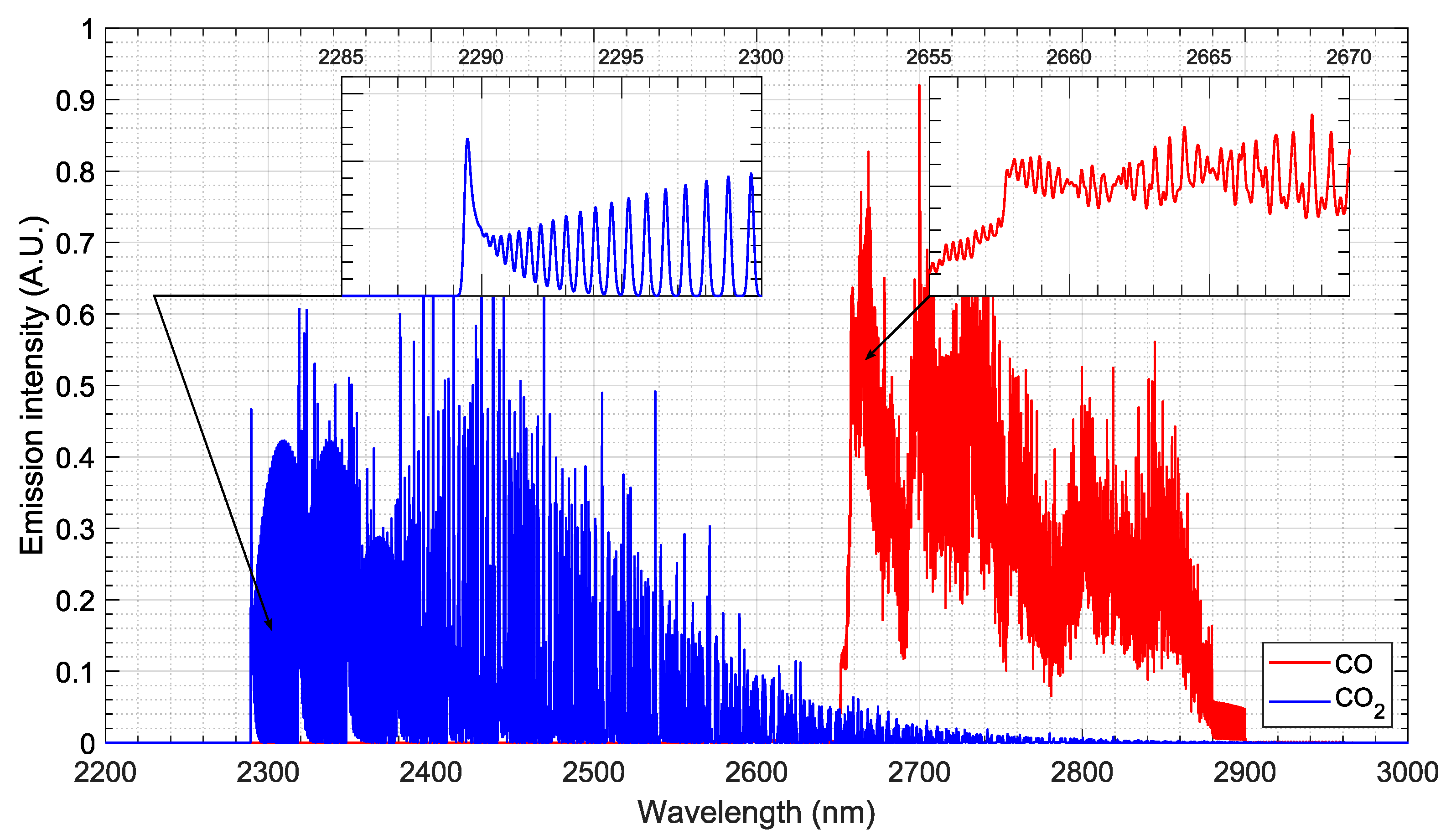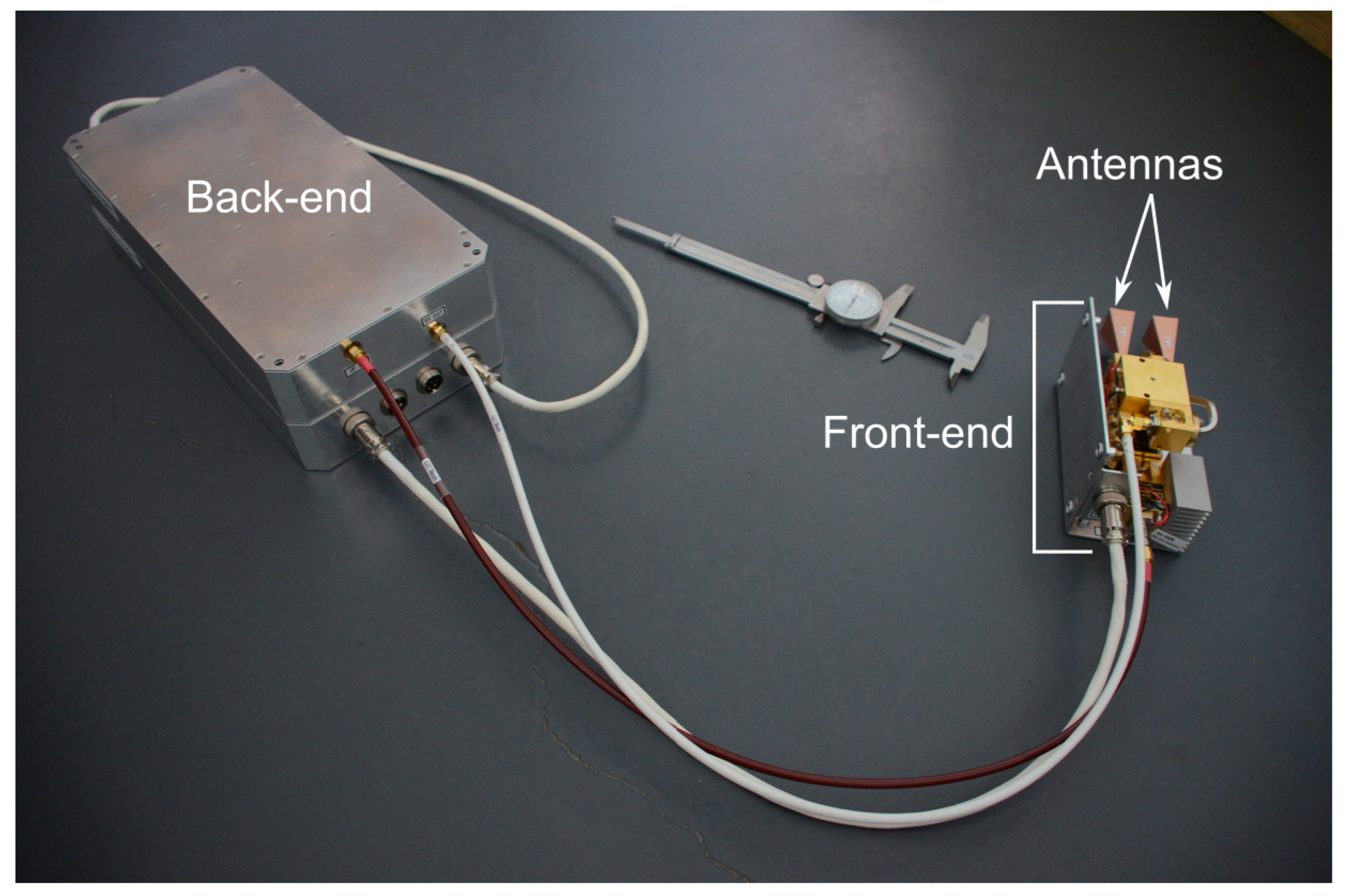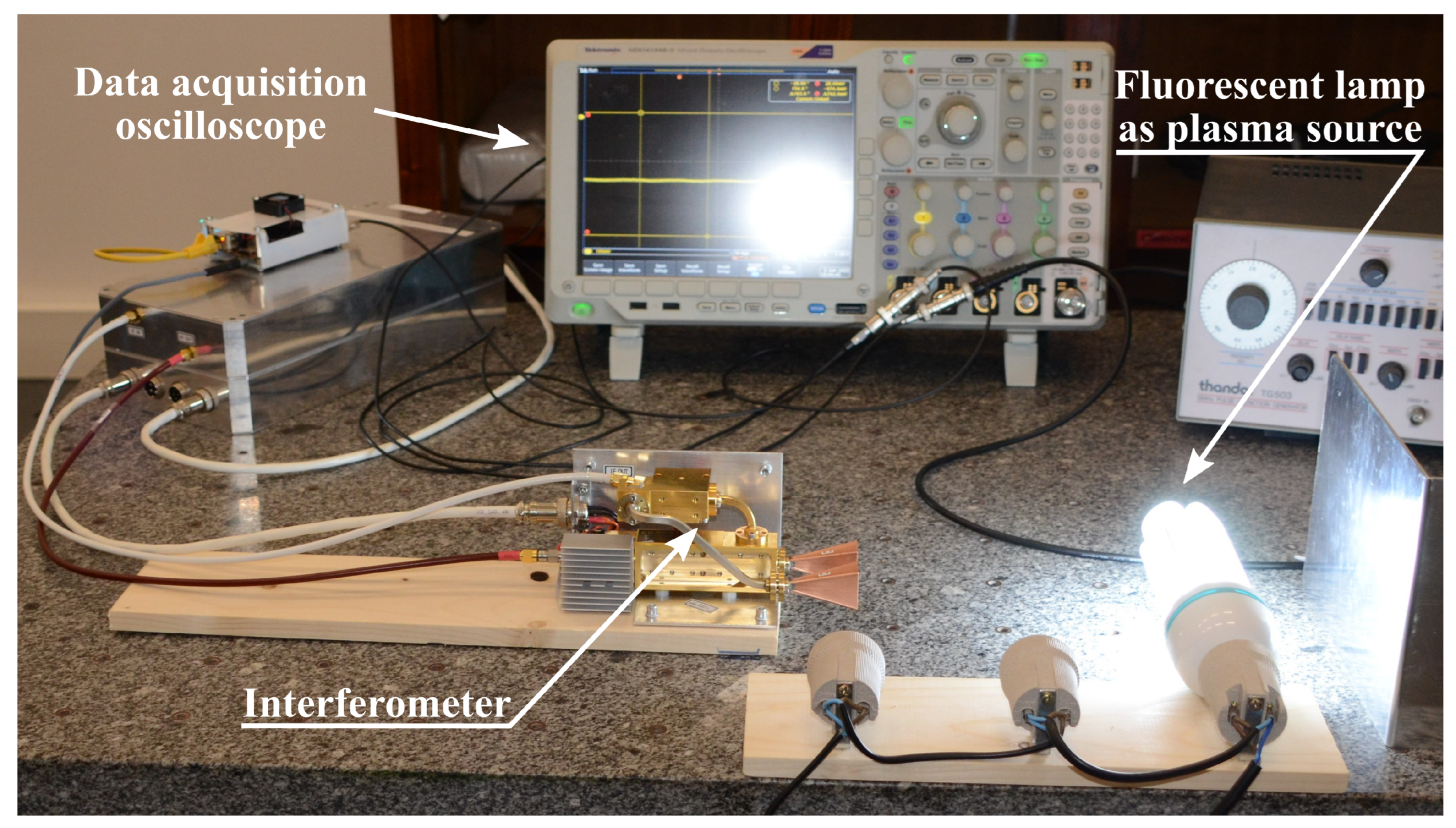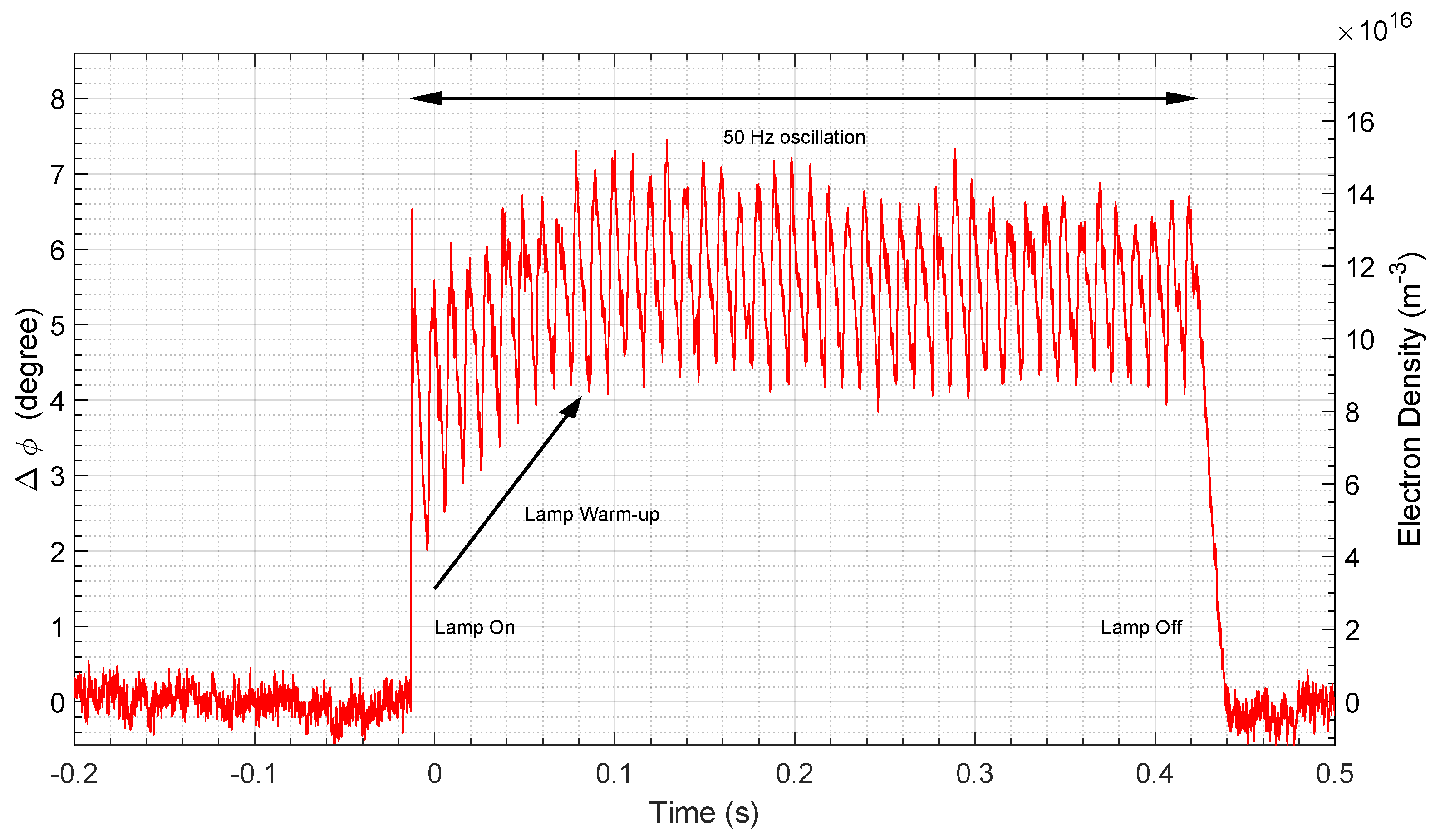This section discusses the operational requirements of shock facilities in terms of shock speeds and ambient pressure, followed by the general requirements for optical spectroscopy measurements. Then, it discusses existing shock tube facilities for atmospheric entry studies, including our own and its expected performance. It then concludes with a more detailed discussion on the requirements for time-dependent optical spectroscopy and microwave interferometry for radiation and electron density measurements, respectively.
2.1. General Specifications and Requirements
Entry conditions are determined by the spacecraft’s orbit into the planet gravitational field. These are then reproduced in key points (typically the peak heating and peak dynamic pressure points), which are obtained through semi-empirical expressions [
27,
28] on adequate ground test facilities, such as ESTHER.
Figure 2 shows the spacecrafts entry conditions in different atmospheres and the corresponding experimental points for different shock tube facilities.
Once the key trajectory points are known, one may estimate the post-shock temperatures that are reached using simple thermodynamic correlations. Namely, the total stagnation enthalpy
of a shock wave system may be expressed as the sum of the internal enthalpy
h, and a kinetic term
due to the flow velocity [
30]. The stagnation enthalpy of the system pre-
and post-shock
can be assumed to be conserved, yielding Equations (
1) and (
2):
Prior to the arrival of the shock wave, the gas is in chemical equilibrium at a low temperature, around 300 K for a shock tube experiment, where the kinetic energy term is dominant on the left-hand side of Equation (
2)
. After the shock, most of the kinetic energy is converted into thermal energy, which both excites the internal energy modes and heats up the gas. Thus, on the right-hand side of Equation (
2), the internal energy term is dominant over the kinetic one
. These approximations yield Equation (
3), with
as the gas specific heat capacity at constant pressure:
The gas total specific heat capacity can be split into two contributions, a constant frozen-gas term
(for an ideal gas), and a contribution from the internal degrees of freedom:
Inserting Equation (
4) into (
2), and solving for
T, we obtain Equation (
5a) and both its upper and lower temperature limits,
(
5b) and
(
5c), respectively.
The expected post-shock temperature range of the gas is shown in
Figure 3. The upper limit (full line) is the so-called frozen limit, where all the chemical reactions are ignored, and thus
; the lower limit (dashed line) is the final temperature after chemical equilibrium is reached. Chemical equilibrium temperatures have been computed using our in-house aerothermodynamics code SPARK.
Figure 4 depicts the radiation wavelength distribution of a Planck blackbody at different temperatures. As the temperature increases, so does the emitted radiation power with
, in line with the law of Stefan–Boltzmann. In addition to this, the peak wavelength of the emitted radiation
moves to the shorter wavelengths following Wien’s law
[
31].
Typically, atmospheric entries occur at a gas pressure low enough that the emitted radiation cannot be assumed to be in equilibrium and treated as a blackbody, yet this assumption provides an upper limit for the emitted radiation over the whole spectral range. In general, the plasma is optically thin, and the discrete radiation spectrum is in strong non-Boltzmann equilibrium. The dominant spectral features will depend on the gas chemical composition and pressure, as well as the temperature (derived from the shock velocity). Entries faster than 7 km/s will usually ionize the gas and thus emit radiation in the ultraviolet region. Slower entries can only excite the molecular internal vibration levels, which radiate in the infrared region.
Figure 5 shows the most important emission regions for typical planetary entries, which is based on experimental data from previous shock tube campaigns by different teams all around the world. Data for Earth, Mars and Venus radiative transitions were taken from [
17,
32], Bose et al. [
33], and Cruden et al. [
34], respectively. Data for Jupiter were adapted from the work of Cruden and Bogdanoff in [
35]. Neptune data were taken from [
36,
37]. Titan data were reported by Magin et al. [
38].
As expected, the radiative features for these different classes of entry flows are quite rich, with a great deal of measured atomic transitions in the VUV region (120–200 nm), the Balmer series of H in the visible, and the O atomic lines in the near-IR region (at 777 nm and at 849 nm, respectively). Molecular radiation features are also very rich, with many emitting systems from C2, CH, CN and N2 all over the visible range, and H2, CO and NO emitting in the VUV range. For the IR, one typically observes emission from the different rovibrational bands of CO and CO2 from 1.5 μm to over 5 μm. These spectral features may now guide us into selecting the appropriate measurement setup.
2.2. Operational Shock Tube Facilities for Fast Atmospheric Entries
Reynier et al. provide a detailed review on hypersonic facilities in [
41,
42]. Currently, the only ground test facilities capable of achieving superorbital velocities (above 10 km/s) are Ames Electric Arc Shock Tube (EAST—Moffett Field, CA, USA); X2 and X3 expansion tubes (Brisbane, Queensland, Australia); CUBRC LENS XX expansion tube (Buffalo, NY, USA); Hyper Velocity Shock Tube (HVST—Tokyo, Japan); TsAGI ADST shock tube (Moscow, Russia); and the T6 Stalker tunnel (Oxford, UK). Typically, shock tubes use emission spectroscopy to determine the chemical composition of the gas behind the shock wave in its non-equilibrium state. Chemical species concentrations may be determined via absorption spectroscopy. The electron density may be estimated via an indirect method, such as the Stark broadening of some emission lines. Nonetheless, some facilities use microwave interferometry to directly measure the electron density behind a shock wave. Electrostatic (Langmuir) probes are simple diagnostics used for electron density and temperature measurements [
43]. However, these are intrusive diagnostics which perturb the flow in the diagnostics region and are damaged by it. Therefore, these drawbacks preclude its use in a shock tube.
EAST [
24,
44,
45] at NASA Ames is equipped with time-of-arrival sensors to have a high-resolution velocity measurement. A long slot optical window is present for shock imaging via spectroscopic instrumentation. A total of four different sets of optics, each with its own spectrometer, perform the imaging at the same axial location. The spectrometers are selected as a function of the region of interest of the electromagnetic spectrum, which itself depends on the shock wave velocity, test gas pressure, and chemical composition. The regions are generally classified as vacuum ultraviolet (120–200 nm), ultraviolet/visible (200–500 nm), visible/near infrared (500–900 nm), near infrared (900–1600 nm) and mid wave infrared (1600–5500 nm). The VUV spectroscopy equipment must operate under vacuum conditions to prevent the ultraviolet radiation to be absorbed along its optical path, and the optical windows must be made of MgF
2 or LiF to minimize absorption.
The University of Queensland hosts three expansion tube facilities, named X1, X2 and X3. The latter two facilities are capable of reaching superorbital velocities and produce VUV and UV radiation. The X2 expansion tube spectroscopy system [
46,
47,
48] consists of a normal incidence spectrometer and an intensified charge coupled device (iCCD) with a camera of enhanced sensitivity in the VUV spectral range. The system has a theoretical resolution of 0.06 nm/pixel, and a range of 60 nm. The UV spectral region can also be observed using the same setup. An additional visible/NIR spectroscopic system is present, with a wavelength range of 695 to 880 nm and 0.55 nm/pixel resolution. The flow is also monitored with a high-speed camera. Besides the emission spectroscopy diagnostics, X2 has Nd:YAG (355 and 532 nm) interferometry instrumentation equipment capable of measuring density, ionization levels, species concentrations and temperatures [
48].
The Japanese HVST [
49] located in JAXA’s Chofu Aerospace Centre is a free-piston-driven shock tube which operates in both shock and expansion tube modes. A He-Ne laser Schlieren setup is used to detect the shock front and measure the shock wave velocity. Three spectrometers covering the VUV to NIR spectral region are coupled to two CCD arrays [
50,
51,
52,
53] for radiation emission spectroscopy.
The LENS XX is a hypersonic expansion tube in Buffalo, N.Y., equipped with an emission spectroscopy system [
54] in the UV to visible with two gratings (1200 and 150 g/mm) and an iCCD camera. The calibration is performed with a deuterium lamp.
T6 [
55] is a Stalker shock tunnel located at the University of Oxford, which may reach velocities up to 18 km/s for light test gases (H
2-He). The emission spectroscopy setup [
56] is based on the X2 expansion tube. A series of UV-enhanced aluminum mirrors focus the light into a spectrograph. A 550 nm longpass filter may be applied for measurements in the red and NIR region of the spectrum. The setup can operate in the 350–850 nm range using either gratings of 150 or 1200 g/mm.
2.2.1. The European Shock Tube for High Enthalpy Research
ESTHER is expected to reach shock wave velocities in the range of 6 to 14 km/s in air or above 18 km/s in (H
2-He mixtures [
29,
57].
Figure 6 depicts a schematic and a photograph overview of ESTHER. The facility is comprised of four sections, separated from each other by diaphragms. These are the combustion chamber driver, the compression tube, the shock tube (also called test section) and the dump tank. A small-scale combustion driver was previously tested in order to de-risk the development of the full-scale driver [
14]. Whereas the qualification tests of ESTHER are ongoing [
15], the tests of the combustion driver were successfully completed. The driver of ESTHER is a 47-liter cylindrical 200 mm internal diameter combustion chamber, capable of handling He:H
2:O
2 or N
2:H
2:O
2 mixtures with filling pressures up to 100 bar and post-combustion deflagration pressures of 660 bar. The combustion chamber and its equipment are designed to operate in deflagration (subsonic combustion) mode. Nonetheless, the driver can withstand the detonations (supersonic combustion), which may occasionally occur creating transient pressures up to 1.8 kbar. The ignition of the mixture is attained using a high power Nd:YAG laser [
58,
59], which fires a 5 ns pulse into the chamber. The compression tube, with an internal diameter of 130 mm, is connected to the driver via a diaphragm designed to open at a predefined pressure. Once filled with helium at pressures between 0.01 and 1 bar, the shock wave moving along the compression tube can reach pressures of up to 70 bar. A second diaphragm divides the compression and the shock tube sections. The shock tube, with a 80 mm internal diameter, is filled with the test gas mixture at pressures between 10 and 100 Pa (0.1 to 1 mbar). The shock wave reaches velocities exceeding 10 km/s in the shock tube, leading to transient pressures reaching up to 20 bar. Pressure sensors and optical detectors are positioned along the shock tube to measure the shock wave velocity and trigger the time-dependent spectroscopic measurements at the test section. Lastly, a 1000 L dump tank, separated from the shock tube by a third diaphragm, recovers the gas flowing in the wake of the shock wave. Following each shot, the liquid phase is drained off, and the remaining contaminated gas mixture is evacuated by the vacuum pumps located in the shock tube section. The tube is then opened for cleaning and diaphragm replacement.
The facility is equipped with 20 ports at 6 different positions along the tube’s axial direction, 4 in the compression tube section and 16 in the shock tube section (8 in the test section). There are two measurement stations at the test section, each with four ports located circumferentially, which allow for multiple diagnostics and measurements at the same axial position. These optical ports have a 10 mm diameter cylindrical shape.
2.2.2. ESTHER Performance Map
The ESTHER performance map was predicted using the STAGG code (Shock Tubes and Gas Guns), developed by Fluid Gravity Engineering Ltd. The code solves the set of shock tube equations given the design variables (cross-section areas, length, single/two-stage geometry) and numerical inputs of the chemical mixtures. The numerical model is based on the works of Alpher and White [
60], Walenta [
61] and Mirels [
62]. The gas is assumed to be isentropic and inviscid [
63] to compute the shock speed and the pressure along the tube. Further details of this development can be found in [
29]. The code was first calibrated using the VUT-1 test data from ESA’s CO
2 validation campaign [
64]. The STAGG simulations were later re-run following the driver qualification campaign, once the driver combustion performance was assessed [
57] in order to have a more realistic performance envelope of the facility.
STAGG simulations were performed in two different modes, optimization and non-optimization. In the first case, the compression tube pressure is adjusted to maximize shock wave velocity at the test section, and in the latter, all input parameters are fixed and the code solves the equations to compute the shock wave pressure, temperature and velocity [
63]. Post-combustion temperatures and pressures were obtained during the driver qualification campaign for different gas mixtures and filling pressures [
65]. During this campaign, the nominal operational mixtures were tuned to He:H
2:O
2 8:2:1.2–1.4 for the high-velocity experiments (>7 km/s) and N
2:H
2:O
2 8:2:1.4 for the low-velocity experiments (<6 km/s). To generate the performance map, STAGG ran three sets of simulations: Helium driver optimization; Nitrogen driver optimization; and Helium driver non-optimization. These correspond to high (>7 km/s), low (<6 km/s) and medium (6–7 km/s) velocity regions. The input parameters for the different sets of simulations are shown in
Table 1. Maximum performance is found when STAGG runs with optimized conditions; however, running it in non-optimized (de-tuned) conditions is also useful to achieve lower shock velocities, extending the operational range.
Figure 7 shows ESTHER performance simulation for Earth’s (N
2-O
2) atmosphere. The envelope is drawn using the lowest and highest velocity points of each simulation group.
2.3. Optical Spectroscopy Specifications and Requirements
Section 2.1 provides us with the operational conditions, pre-shock pressure and target speed, for our setup, and more specifically,
Figure 5 provides us with the specific wavelengths of interest for the different gas mixtures considered in the testing. However, the wavelength alone is not sufficient for the specification of the equipment, as one needs to consider as well the shock speeds. These will define the acquisition time, and in turn, the temporal/spatial resolution of the system. The design of the trigger system and of the fast spectroscopy electronics is also influenced by the shock wave speed; the total time should be about 20 μs at worst (for maximum operational speeds).
Another two important parameters are the spectroscopic resolution and the sensitivity of the system. In terms of the spectroscopic resolution, typical spectroscopic systems which work in monochromator mode try to target the best possible resolution, as they are typically deployed in steady-state experiments, where the wavelength can be slowly scanned and acquisitions (either via a photomultiplier or an intensified camera) can be tailored to be long enough so that a good signal-to-noise ratio is achieved. An example for such a setup is described in Ref. [
66]. In the case of a shock tube facility, we are collecting light trailing a moving shock wave for a few μs in an experiment that is typically one or few hours in the making. Not only is a spectrograph setup (imaging the full spectral window in one sweep) mandatory, but one needs to ensure that the maximum amount of light is collected during the passage of the shock wave. Therefore, there is a need to ensure that the setup collects the maximum possible amount of light, as well as a need to tailor the spectral window. For the latter, higher spectral resolutions yield lower spectral windows and vice versa. The spectral resolution is determined by the gratings installed in the spectrograph, which can be exchanged. The separation of different wavelengths is called the angular dispersion
and can be computed as the derivative of the reflection angle
with respect to the wavelength
:
where
a is the groove distance in the grating (inverse of the groove density). The reflection angles in Equation (
6) can be calculated by
where
k is the order of diffraction (1, 2, …). For a set of
a and
, multiple
satisfy Equation (
7). The lowest-order solution,
, corresponds to the longer wavelength
, with higher order solutions corresponding to
. The dispersion of the wavelength at the spectrograph focal plane with focal distance
f is computed through
A first-order Littrow blaze can be applied to the diffraction grating. It increases the intensity of the refraction order and wavelength of interest by curving the grating surface to direct the light at a preferred angle. These governing equations are useful for defining which gratings will be best suited in terms of apparatus function and spectral window.
Broadly speaking, three different spectral regions (each with its own peculiar characteristics) are identified:
The ultraviolet and vacuum ultraviolet regions where most of the radiation for high-speed entries should be emitted (see
Figure 4). This region is bounded roughly between 120 nm (below which most windows become opaque) and 300 nm (where the visible region begins).
The near-UV to near-IR region in the 300–850 nm range, colloquially referred as the visible range, where many atomic and molecular systems are emissive for moderate entry speeds (see
Figure 5).
The near-IR to mid-IR region (roughly in the 1–5 μm range) where rovibrational transitions between heteronuclear molecules, such as CO
2, CO, and NO, are strongly emissive. Radiation is observed in this spectral range for low-speed entries in planetary atmospheres with such gases in their composition (mostly Mars, for which the large impact of IR CO
2 radiation was recently assessed [
19,
67]).
Each of these three spectral regions requires its own setup. This means selecting an adequate spectrograph/camera combo. In terms of spectrographs and beyond the selection of appropriate gratings, one needs to account for the absorption of room air, which encompasses all the spectral ranges below roughly 200 nm, and specific bands in the IR (owing to the trace amounts of CO2 and water vapor). This means that a VUV setup needs to be held in vacuum, and an IR setup typically needs to be flushed in an inert non-IR absorbing gas, such as Nitrogen. The camera itself needs to be sensitive to the spectral range of interest. Intensified high-speed cameras (iCCD) encompass all the spectral ranges of interest of this work, whereas streak cameras are limited to the UV-VUV and visible ranges. Streak cameras have an advantage over iCCD cameras in the sense that the temporal variations of light intensity at an imaged point are translated to variation in image brightness along the streak direction. In contrast, iCCD cameras sample a line of points where the shock wave evolves over a given acquisition time, hence translating spatial points into time through the shock wave speed. These cameras are subject to motion blur, whereas streak cameras are not. Nonetheless, the deployment of the latter for higher speeds is more arduous. Whereas IR is the only spectral region where streak cameras do not exist, the shock waves are slower and therefore the issue of motion blur is less critical.
The optimal setup selection is therefore schematized in
Figure 8. The detailed specifications and requirements for these equipment, as defined by ESA, are presented in
Table 2 and can now be discussed in detail. Note that no specifications and requirements have been defined in the visible region, as the optical setup from the previous TCM2 shock tube is reused.
These specifications and requirements were defined taking into consideration the generic characteristics for spectroscopic setups in their spectral regions. These are understood to be adjustable for a shock tube configuration. In terms of spectral range, resolution and accuracy, most of the commercially available spectrograph equipment are compliant to the specified parameters. In turn, most of the streak and iCCD cameras are capable of achieving integration times lower than 1 μs. The specification of the signal-to-noise ratio will be more experimentally dependent on the amount of radiation emitted by the shocked flow, which then will drive the requirements to minimize stray light and general noise from the acquisition system.
With this said, the assembly and deployment of a setup for detecting short bursts of light typical of shock tube experiments entail a certain number of restrictions, which immediately narrow down the range of compliance to the specifications and requirements of
Table 2. Among others, one needs to account for window transmissivity; spectral response, range and sensitivity of the streak/iCCD camera photocathode/CMOS sensor, respectively; bit-rate for the high-speed electronics of the cameras; and availability of fiber optics to connect the spectrograph to the shock tube optical windows. All these narrowed-down specifications and requirements are discussed in detail in
Section 3 (taking into account the spectral region, either UV-VUV or IR), except for the window transmissivity, which is discussed here.
VUV light is easily absorbed by gas molecules, and most optical materials, such as quartz or glass. This mandates the VUV system be held in vacuum to prevent the collected light from being absorbed by oxygen and nitrogen molecules. Using an optical fiber cable is also not possible as these have strong attenuation below 300 nm. Alongside, the optical window material should be as transparent as possible in the 100–300 nm range.
Figure 9 and
Table 3 show the optical transmissivity of different materials in the VUV region. Usually, VUV windows are made of Lithium Fluorite (LiF) or Magnesium Fluorite (MgF
2); however, these materials cannot handle the force of the passing shock wave and will break after two or three experimental runs. For this reason, VUV-graded sapphire was the material chosen for the windows of the spectroscopy system. Regarding the NIR-MWIR spectral region, all the aforementioned optical windows materials are essentially transparent up to 4–5 μm, and there is the additional advantage that infrared optical fibers are available to “transport” the light signal from the shock tube to the spectrometer. These have low attenuation in the infrared region [
68] and do not require vacuum like the VUV wavelengths.
2.4. Microwave Interferometery Specifications & Requirements
Interferometry is an adequate technique for electron density diagnostics in shock tubes since these lack any radial profile (in other words, the shock wave front moves as a “disk” over the tube). Other than a small test campaign carried out at the Moscow Institute of Physics and Technology [
41,
64,
77,
78], in the scope of an ESA contract, there are no further direct electron density measurements in hypersonic shock tube facilities using this technique to the authors knowledge. Most plasma interferometry measurements were performed in combustion shock tubes [
79] or to measure ionization rates [
80]. Interferometry is a common diagnostic in plasma plumes, namely Hall thrusters, because of its non-invasive nature. Examples of this diagnostic include measurements made in Xenon [
81,
82,
83,
84,
85], and Hydrogen [
86]. A recent review on the applicability of this technique for atmospheric entry applications is provided in [
26].
The plasma cut-off frequency
is the minimum value at which an electromagnetic wave can propagate in a plasma. It relates to the critical electron density
via Equation (
9) [
43], where
,
e and
are the vacuum permittivity, the electron charge and mass, respectively:
The cut-off frequency is a key parameter to design any microwave diagnostic. In microwave reflectometry, commonly used in fusion reactors [
43,
87], the electron density profile is diagnosed using a radar-like technique with microwaves. A probing signal is emitted to the plasma, where it propagates until a layer with
equal to the critical value
is found, and is then reflected. The phase difference of the two signals relates to the time of flight of the probe signal and to the plasma refraction index. The latter is associated with the plasma density via the Altar–Appleton equation [
88]. Microwave interferometry uses a similar principle to reflectometry; however, the probing signal must completely transverse the plasma. The phase gained by the signal compared to the reference will relate to the average electron density of the plasma. To create a spatial plasma profile, the signal must be de-convoluted via Abel-inversion (“onion-peel”) techniques. Both techniques can work monostatically with one antenna for wave emission and reception, or bistatically with one antenna dedicated for emission and another for reception. More details on the specifics for this technique may be found in Ref. [
89].
The functional requirements of an interferometer mandate that it should be compact and self-sufficient so it can be assembled and tested in different facilities with ease. Namely, its antennas, emitting and receiving, must be compatible with ESTHER optical plug windows (diameter 10 mm). Its working frequency (
f) must be sufficiently high to traverse the plasma without reflecting back, and gain a phase delay [
89] significantly large to be detected. The phase shift is given by Equation (
10), where
D is the plasma thickness, and
and
are the plasma oscillation and probing angular wave frequencies, respectively:
Using Equation (
9),
, and (
), Equation (
10) can be simplified into
where
is the average electron density over the plasma path. This integrated value is a very good approximation to shock tube measurements, as the plasma can be approximated to a disk whose properties change only in the longitudinal direction. Optimally, the working frequency should be high enough to transverse the plasma and guarantee
. However, if it is too high (small
), the phase gained may be too small and too difficult to measure. Alongside working as a interferometer, the base equipment base should be convertible to a reflectometer to be mounted on a small spacecraft.
Since not much experimental data are available for direct electron density measurements, a set of CFD (Computational Fluid Dynamics) simulations was performed to estimate the required range for the diagnostics equipment. Shock wave conditions were estimated through the chemical reactive CFD code SPARK (Software Package for Aerothermodynamics, Radiation and Kinetics) [
90]. The code is capable of computing the chemical composition behind the shock wave and its respective electron density and emission radiation. A total of six simulation runs were carried out in 1D (post-shock relaxation) conditions.
Table 4 shows the CFD simulations initial conditions and references for the chemical–kinetic reactions schemes, as well as for the chosen velocity and pressure conditions. The representative cases are a sample return mission to Earth, and the ExoMars, Huygens and Galileo missions to Mars, Titan and Jupiter, respectively. Simulation conditions for Neptune and Venus were taken from trajectory calculations. The electron densities for these cases are depicted in
Figure 10, where the electron density can reach values of
electrons/m
3 for the case of a Venusian entry. The typical electron density profile has a sharp rise right after the shock front, followed by a slower decay until chemical equilibrium is achieved.
As a side note, one needs to point out that Stark broadening measurements of the H-
and H-
lines provide an interesting technique for electron density analysis [
24,
25]. This may be considered a non-intrusive diagnostic to some extent, as a small percentage of the flow is replaced with Hydrogen (~
). The Hydrogen atom
line at 656 nm and Balmer
line at 486 nm then typically become visible without significantly perturbing the overall spectrum. The observed lines may then be fitted to a Lorentzian curve with all other individual broadening contributions, van der Waals collisional, Doppler and instrument, accounted for. The FWHM (full width at half maximum) for the emission peak may then be compared to tabulated values, such as the ones found in [
97], which give an estimation of the electron density. As a caveat, we note that the addition of (even small) quantities of H into the flow may affect wall desorption and slightly alter the flow properties; however, this effect should be relatively limited as shown by Cruden [
24].
